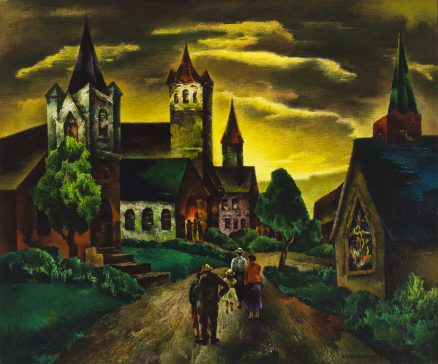- Categories
- Immigrant artists
- Landscapes
- Zoom in on Artwork
- Print Page
- Email Page to Friend
The fancifully tinted steeples of four churches thrust upward toward a brooding sunrise or sunset sky in William S. Schwartz’s Church Corner. Following a conventional landscape format, the composition is organized around a centrally placed road that invites the viewer into the space bounded on either side by the blocky forms of the churches. On the road, various figures in brightly tinted garb are apparently church-bound; several others are silhouetted in an illuminated doorway on the distance. In the foreground, a woman seems held in intent conversation with a man whose taller form mostly obscures her face. Light shines from or is reflected by the windows of the church buildings, yet these structures seem closed and impenetrable, just as the figures mostly turn their backs to the viewer. Schwartz infused an ominous quietude into the scene, an unlikely streetscape where the churches, the only structures visible, impart a subtly menacing presence.
In his early paintings Schwartz draw direct inspiration from boyhood memories of his native Smorgan, a town in rural Russia whose largely Jewish population had long suffered under Cossack persecution. By the late 1920s, established as an artist in Chicago, he adapted the theme of village life to American, especially midwestern, settings at a moment when many artists were to responding to calls to paint the “American scene.” Schwartz made many sketching trips to rural Wisconsin, especially to Baraboo and Briggsville in the Wisconsin Dells. In addition to watercolor portraits of rural character “types,” he painted village scenes such as Church Corner. The figures in these works—described by a contemporary as “highly characteristic of the American small town . . . in their costumes, contours and postures”—are subordinated to picturesque architecture and verdant surroundings that hint at bountiful nature.i
Schwartz’s take on small-town life in his adopted country could be idyllic, reflecting a city-dweller’s idealization. Church Corner, however, evokes the sense of unease the artist may have felt as a Jewish, foreign-born Chicagoan in the American—and uniformly Christian—heartland. In 1940, while sketching in Appleton, Wisconsin, the artist was ordered to leave on suspicion of spying, according to a local newspaper report, which commented that “the crack of the whip Hitler handles in faraway Germany was felt in the Fox river valley.”ii Probably painted within a few years of this incident, Church Corner reflects the somber mood of wartime. Schwartz included the painting in his solo exhibition at the Associated American Artists Gallery in New York in December, 1943, along with another work whose title, Lebensraum, records his defiance of Nazi racist ideology. The dark tone of Schwartz’s show impressed itself on the reviewer for the New York Times, who wrote that the artist “is very earnest and sometimes solemn,” while “there is something apocalyptic (the word springs irresistibly) about his painting.”ii
Wendy Greenhouse, PhD
i Oshkosh Northwestern, quoted in June Provines, “Front Views and Profiles,” Chicago Tribune, Sept. 3, 1940.
ii “Briefer Mention,” New York Times, Dec. 12, 1943.
